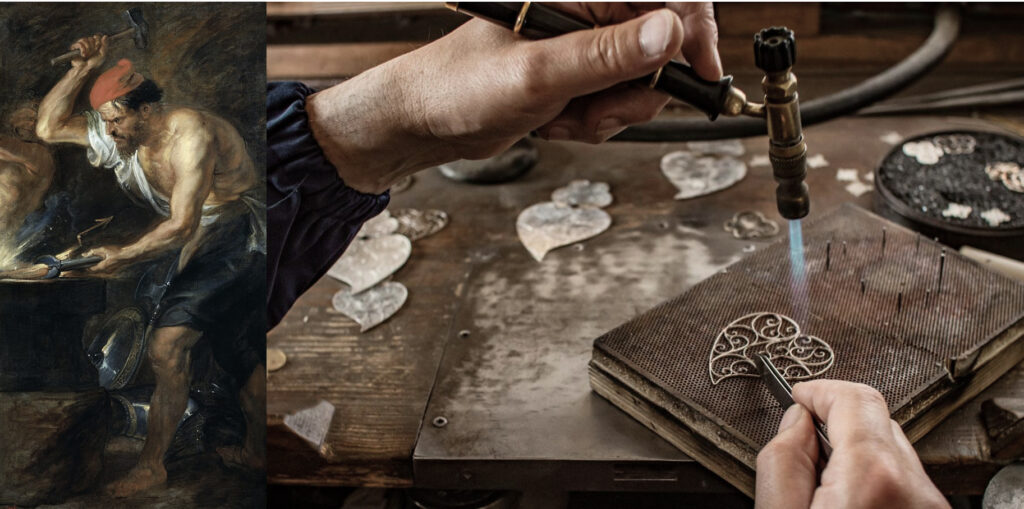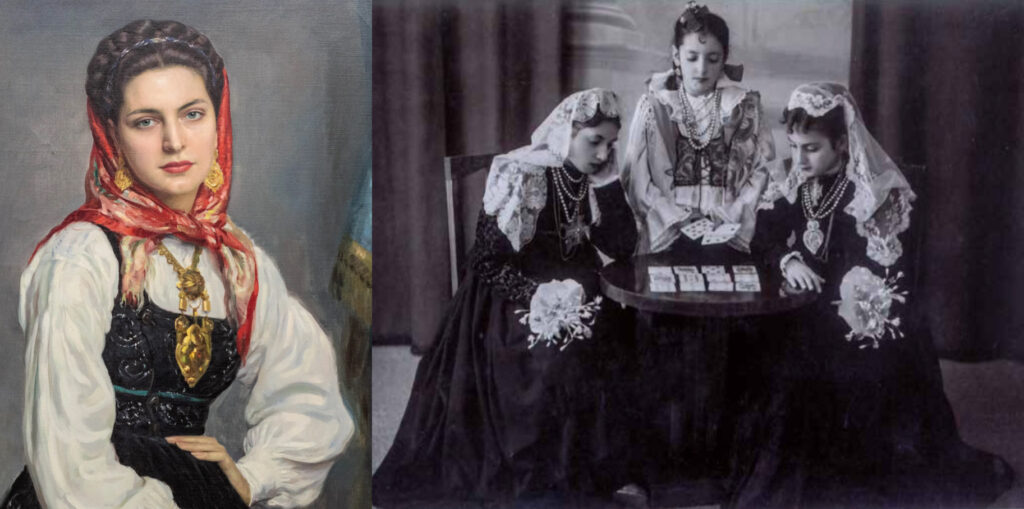Filigree is more than a goldsmith’s craft; it is a ritual of brightness and lightness. Through its woven threads and delicate voids, rays of sunlight unveil the golden web, casting a dance of shadows and brilliance. This golden lace evokes the profound mysteries of existence: life and death, the eternal and the fleeting. It is a millennial technique, a testament to the capabilities of the Portuguese hand—a hand that has mastered the essence of materials and transformed hidden dreams into sophisticated expressions of wealth and history, encapsulating brilliance in the hearts of the Portuguese.
Its meticulous logic serves as a metaphor for undefined, immaterial concepts, transcending simple worked metal to reveal the spirit of a nation. For centuries, Portugal has celebrated craftsmanship as a living testimony to its culture and tradition. Filigree, recognised as Intangible Cultural Heritage in Portugal, has become a national icon that embodies the Portuguese soul.
Filigree Production Process
Creating Filigree is a complex and detailed process. Initially, metal is melted in a crucible and cast into a cast to form a thin rod. This rod is then stretched using a wire pulling bench to produce a fine thread. The thread is subsequently made even finer by passing it between two boards, preparing it to be intricately intertwined into a braid. Finally, the thread is pressed by a smooth cylinder—a task traditionally performed with hammers—to give it the distinctive grainy texture characteristic of Portuguese Filigree.
The Filigree thread, which varies in thickness and length, comprises two extremely fine filaments that have been twisted and beaten. Crafting the intricate lacy designs, which often depict themes of love and religion, requires the use of more than ten different tools. The most renowned piece produced in Portugal is the elongated “Heart of Viana.”

Legend: Vulcan Forging the Thunderbolts of Jupiter by Peter Paul Rubens (ca. 1636); Production of Heart of Viana.
Though traditionally the domain of men, metalwork often holds significant meaning in the feminine universe. In Greek mythology, the beautiful goddess Aphrodite chose the unattractive Hephaestus as her lover because, as the blacksmith of the gods, he could make her the best-adorned deity of Olympus.
Historical and Cultural Context
This jewellery-inspired design has been present in various European cultures since medieval times. While it has largely declined or even disappeared in most places, in northern Portugal, particularly the Minho region, Filigree has remained an integral part of contemporary culture. Like legends, its history is primarily oral. The artisans who possessed this knowledge passed it down through generations. Often, these artisans were illiterate, leading to gaps in the documented history of Portuguese Filigree, which is now regarded as some of the finest in the world.
During the Age of Discoveries, gemstones became more popular than gold, leading to the incorporation of precious stones into Filigree designs, often featuring imperial symbols such as caravels. The Church commissioned reliquaries and crosses embedded with stones. In the 20th century, Filigree also became a medium for creating ethnographic pieces, depicting ox carts, rabelo boats, and caravels.
In the 19th century, this design was particularly popular among women, becoming a symbol of wealth and social status among peasants and farmers, who were often the creators of these pieces. Goldsmiths commonly worked in the fields by day and made Filigree by night, sometimes with the help of their families, including children. Women known as “enchedeiras” also worked on these pieces at night, contributing to the family finances.
The purchase of gold jewellery became a ritual that rewarded hard work, leading Minho families to accumulate gold as savings. These savings grew over generations and became a cherished inheritance. Young women used these savings as a dowry for a good marriage. This transformation into a form of popular art endowed Filigree with its current artistic and social significance. The traditional bride from Minho would marry in black, enhancing the brilliance of her gold collection. The traditional bride from Minho would marry in black, enhancing the brilliance of her gold collection.

Estela Varejão by Henrique Medina, Minho, 1957; Minho Brides, 1950.
From the mid-19th century, and especially in the 20th century, Filigree has gained a new life in the hands of jewellery designers who recreate its essence, freeing it from religious concepts. They found fresh and creative applications in various objects such as chests, jewellery boxes, cigarette cases, and powder boxes, as well as men’s watch chains. Interestingly, many of these objects belong to the female world and hold significant symbolic value.

Sharon Tate using Heart of Viana neckless; Queen of Letícia of Spain wearing Filigree earrings; Mila Jovovich in Portuguese Jewllery campaign.
These pieces are destined to enlighten the sensual parts of the female body: the ears, neck, and bust. Chains, beads, and hearts are layered, almost as if to conceal the breasts. The heart, which has become the most iconic symbol of Portuguese Filigree, represents life, courage, and memory.
Modern Revival of Filigree
Following years of decline, the 21st century has witnessed a renewed interest in Filigree, driven by designers exploring modern systems in goldsmithing and jewellery. The growth of the country’s tourist sector has also contributed to this resurgence.
Coming to full circle, we can reiterate that indeed Filigree is not just an ornamental craft; it is a testament to the enduring spirit and creativity of the Portuguese people. Through its intricate designs and timeless beauty, those twisted golden threads continue to tell the story of Luso culture and traditions. It is a permanent vibrant link to our past as it evolves and embraces new techniques and inspirations. In a rapidly changing world, this craft stands proud and firmly as a symbol of the Portuguese soul, bridging generations, and a living art form that celebrates the richness of the Portuguese history and the brilliance of its future.

